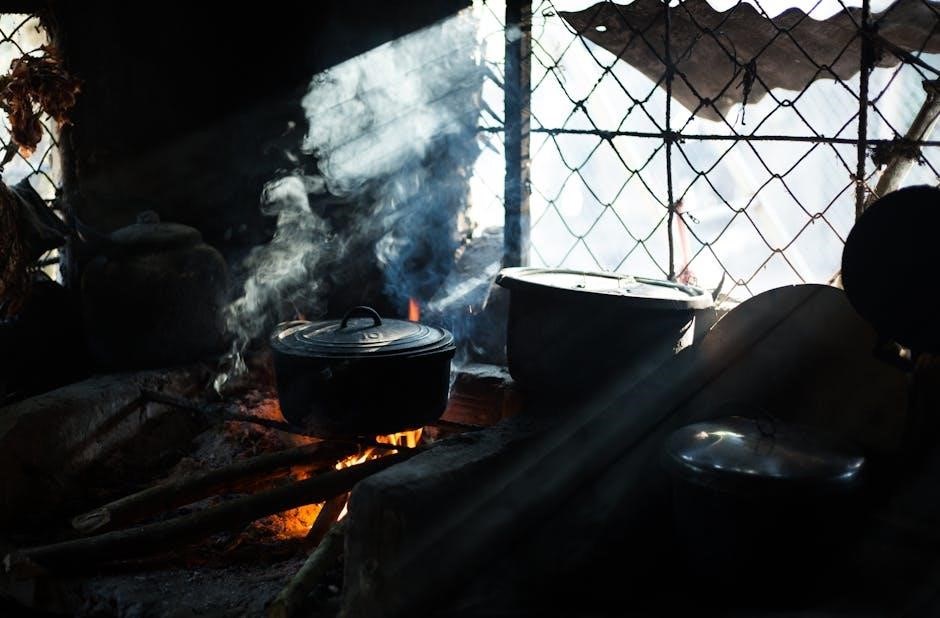The original Crock-Pot manual is an invaluable resource, offering a complete guide to understanding and using your slow cooker. It provides essential information on setting up, operating, and maintaining your device. The manual also includes safety guidelines, recipes, and troubleshooting tips for optimal usage.
Finding Your Specific Crock-Pot Model Manual
Locating the precise manual for your Crock-Pot model is essential for safe and effective use. Start by checking the product packaging, as the manual is often included. If you no longer have the original packaging, inspect the slow cooker itself for a model number, typically found on a sticker at the bottom or back of the unit.
Once you have the model number, visit the official Crock-Pot website. Most manufacturers offer digital versions of their manuals online. Navigate to the “Support” or “Manuals” section and enter the model number in the search bar. If the manual is available, you can usually download it as a PDF file.
If you are unable to find the manual on the official website, try searching online using search engines. Type “Crock-Pot manual” followed by your model number. This may lead you to third-party websites that host manuals. Be cautious when downloading from unofficial sources to avoid malware.
Another option is to check online forums and communities dedicated to cooking and appliance repair. Other users may have a copy of the manual or be able to provide assistance. Finally, consider contacting Crock-Pot customer support directly. They may be able to email you a copy of the manual or provide guidance on finding it.

Key Features and Components Explained
Understanding the key features and components of your Crock-Pot is crucial for optimal use and longevity. The primary component is the stoneware crock, a removable insert where the food cooks. This crock is designed to distribute heat evenly and retain it for extended periods, ensuring thorough cooking.
The outer housing contains the heating element, which gently warms the crock. Most Crock-Pots feature a temperature control knob or digital interface, allowing you to select low, high, or warm settings. Low is ideal for long, slow cooking, while high is suitable for quicker meals. The warm setting keeps food at a safe serving temperature after cooking.
The lid is another essential component, trapping heat and moisture inside the crock. Lids are typically made of glass or ceramic, allowing you to monitor the cooking process without lifting the lid and releasing heat. Some models also feature locking lids for easy transport.
Handles on the housing and crock provide a safe grip when moving the appliance. Most Crock-Pots also include a power cord, which should be plugged into a grounded outlet. Familiarizing yourself with these components will help you use your Crock-Pot safely and effectively, ensuring delicious and perfectly cooked meals every time. Refer to your model’s manual for specific details.

Safety Instructions and Important Safeguards
Prioritizing safety is paramount when using your Crock-Pot. Always read the safety instructions in the manual before operating the appliance. Ensure the Crock-Pot is placed on a stable, heat-resistant surface away from flammable materials. Never immerse the base in water or any liquid; it contains electrical components that could cause shock.
Avoid using the Crock-Pot near water or in damp environments. Do not operate the appliance if the cord or plug is damaged. Regularly inspect the cord for wear and tear, and replace it if necessary. Always unplug the Crock-Pot when not in use and before cleaning.
When handling the stoneware crock or lid, use oven mitts or pot holders as they can become extremely hot during and after cooking. Allow the Crock-Pot to cool completely before cleaning. Never place a hot crock directly onto a cold surface, as this could cause it to crack.
Keep the Crock-Pot out of reach of children and pets. Supervise children when the appliance is in use. Do not use the Crock-Pot for purposes other than those specified in the manual. Following these safety instructions and important safeguards will help prevent accidents and ensure safe and enjoyable use of your Crock-Pot.
How to Use Your Manual Crock-Pot
Using your manual Crock-Pot is straightforward, making it a convenient option for slow cooking. Start by placing the stoneware crock inside the heating base. Add your ingredients to the crock, ensuring not to overfill it, typically leaving at least an inch of space from the top. Refer to your recipe for specific ingredient measurements and cooking times.
Once the ingredients are in the crock, secure the lid on top. Plug the Crock-Pot into a functioning electrical outlet. Manual Crock-Pots usually have a simple control knob or switch with settings like “off,” “low,” “high,” and sometimes “warm.” Select the appropriate heat setting based on your recipe.
“Low” is ideal for longer cooking times, typically 6-8 hours, while “high” is suitable for shorter durations, around 3-4 hours. Monitor your dish during the cooking process, but avoid frequently lifting the lid, as this releases heat and extends cooking time.
Once cooking is complete, switch the Crock-Pot to the “warm” setting if you want to keep the food at serving temperature. Remember to unplug the Crock-Pot when not in use and allow it to cool completely before cleaning. Consult your manual for specific instructions related to your model.

Cleaning and Maintenance Guidelines
Proper cleaning and maintenance are essential for prolonging the life of your Crock-Pot. Before cleaning, always ensure the Crock-Pot is unplugged and completely cooled down to prevent any burns or electrical hazards. The stoneware crock is usually removable and dishwasher-safe, making cleaning more convenient. However, always check your specific model’s manual for confirmation.
If hand washing the crock, use warm, soapy water and a non-abrasive sponge or cloth to avoid scratching the surface. For stubborn, stuck-on food, soak the crock in warm, soapy water for a while before attempting to scrub it. Avoid using steel wool or harsh scouring pads. The lid can also be washed in the dishwasher or by hand with warm, soapy water.
The heating base should never be submerged in water or any other liquid. To clean the base, wipe it down with a damp cloth. Ensure that all parts are completely dry before reassembling and storing the Crock-Pot. Regularly inspect the power cord for any damage and avoid using the appliance if the cord is frayed or damaged.
Store your Crock-Pot in a dry place, away from extreme temperatures. By following these guidelines, you can ensure your Crock-Pot remains in good working condition for years.
Troubleshooting Common Issues
Encountering issues with your Crock-Pot can be frustrating, but many problems have simple solutions. One common issue is the Crock-Pot not heating up. First, ensure the appliance is properly plugged into a working outlet. Check the power cord for any damage. If the Crock-Pot still doesn’t heat, the heating element may be faulty, requiring professional repair or replacement.
Another frequent problem is food cooking unevenly. This can occur if the Crock-Pot is overcrowded. Ensure food is cut into uniform sizes and avoid overfilling the crock. If food is cooking too quickly, reduce the cooking time or lower the heat setting. Conversely, if food is taking too long, increase the heat setting or add a bit more liquid.
Sometimes, the lid may not fit properly, causing steam to escape. Ensure the lid is correctly positioned and that the sealing gasket, if present, is clean and undamaged; If the lid is cracked or warped, it may need replacement.
If you notice a burning smell, immediately unplug the Crock-Pot and check for any food stuck to the bottom or sides of the crock. Clean thoroughly and restart the cooking process. Always refer to your Crock-Pot manual for specific troubleshooting steps related to your model.

Original Crock-Pot Recipes and Cooking Tips
The original Crock-Pot manual isn’t just a guide to operation; it’s a treasure trove of classic recipes and essential cooking tips to maximize your slow-cooking experience; One timeless recipe is the classic pot roast. Simply sear a beef chuck roast, then place it in the Crock-Pot with potatoes, carrots, onions, and beef broth. Season with salt, pepper, and herbs for a hearty, flavorful meal.
Another popular dish is chili. Combine ground beef, beans, diced tomatoes, onions, peppers, and chili seasoning in the Crock-Pot for a satisfying, easy-to-prepare meal. For a sweeter option, try apple crisp. Combine sliced apples, oats, brown sugar, cinnamon, and butter in the Crock-Pot for a warm, comforting dessert.
When slow cooking, always ensure there is enough liquid to prevent burning. Browning meat before slow cooking enhances flavor and texture. Avoid lifting the lid frequently, as this releases heat and prolongs cooking time. Use tougher cuts of meat, as slow cooking tenderizes them beautifully. To prevent mushy vegetables, add them later in the cooking process.
Experiment with different herbs and spices to customize your recipes. With these recipes and tips, your Crock-Pot will become your go-to appliance for delicious, hassle-free meals.
Warranty Information and Service Instructions
The original Crock-Pot manual includes crucial warranty information, typically covering defects in materials and workmanship from the date of initial retail purchase. The warranty is usually valid for a specified period, often one year, and is applicable to the original retail purchaser only, non-transferable. To claim the warranty, retain your purchase receipt as proof of purchase.
The warranty does not cover damage caused by misuse, accidents, alterations, or commercial use. Before seeking warranty service, consult the troubleshooting section of the manual to resolve common issues. If the problem persists, contact the manufacturer’s customer service, details of which are in the manual, for assistance.
For service instructions, the manual emphasizes avoiding any attempts to repair or adjust electrical or mechanical functions, as this voids the warranty. If a unit exchange is necessary, return it in its original carton. The manual typically provides guidance on how to pack the product to avoid damage during shipping.
Always follow the manual’s instructions for safe usage and maintenance to prevent issues and maintain warranty eligibility.
Evolution of Crock-Pot Slow Cookers
The Crock-Pot, originally a simple bean cooker, has undergone a significant evolution, transitioning from a basic appliance to a diverse line of slow cookers and accessories. Initially designed for ease of use with manual settings, modern Crock-Pots now feature programmable options, digital displays, and smart technology. Early models focused solely on low and high settings, while contemporary versions offer precise temperature control and timers.
The evolution extends to design, materials, and features. Original Crock-Pots had a standard aesthetic, whereas today’s models boast various finishes, including stainless steel and matte textures, catering to different kitchen styles. Removable stoneware, a consistent feature, has been improved for durability and ease of cleaning.
Functionality has also expanded; many Crock-Pots now include multi-cooking capabilities, such as pressure cooking and steaming. Innovations like WeMo Smart slow cookers allow remote control via smartphones. The brand continues to adapt to modern cooking needs, emphasizing convenience and versatility.
This evolution reflects the Crock-Pot’s commitment to making meals smarter, easier, and more convenient for diverse cooking styles.